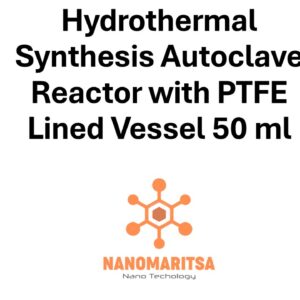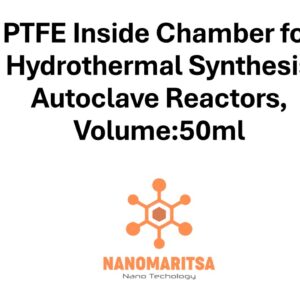PTFE Inside Chamber for Hydrothermal Synthesis Autoclave Reactors, Volume:500ml
€384.00
ComparePTFE Inside Chamber for Hydrothermal Synthesis Autoclave Reactors (500 ml) is a specialized component designed for use in hydrothermal synthesis autoclave reactors. The chamber is where high-pressure and high-temperature chemical reactions occur, enabling the synthesis of a variety of advanced materials. This component is used in laboratory or industrial settings for the controlled synthesis of nanoparticles, crystals, and other complex materials. Below is an overview of its key features, properties, applications, and handling considerations:
1. Key Features:
- PTFE Lining: The PTFE (polytetrafluoroethylene) inside chamber provides exceptional chemical resistance and inertness, ensuring that no unwanted chemical reactions take place between the chamber and the reactants. This is particularly important in hydrothermal synthesis, where aggressive chemicals and solvents are often used.
- Volume (500 ml): With a 500 milliliters (ml) volume, the chamber is suitable for larger-scale hydrothermal reactions compared to smaller chambers. This volume is ideal for research or industrial applications requiring larger quantities of synthesized material.
- Pressure and Temperature Resistance: The PTFE chamber is designed to withstand the high pressures (200-300 bar) and high temperatures (150°C to 250°C) that are characteristic of hydrothermal reactions. This allows the reactor to operate effectively under the extreme conditions required for synthesizing advanced materials.
- Sealed Environment: The PTFE chamber is sealed within the autoclave reactor, providing a controlled environment in which the reaction occurs. This ensures precise control of reaction conditions, such as pressure and temperature, throughout the process.
2. Properties:
- Chemical Inertness: The PTFE material is highly resistant to a wide range of chemicals, including acids, bases, and solvents, ensuring that the chamber does not interact with the reactants inside. This property is essential for maintaining the integrity of the reaction and ensuring that no contamination occurs.
- High Temperature and Pressure Resistance: The PTFE chamber can endure high temperatures (up to 250°C) and high pressures (up to 300 bar), making it ideal for hydrothermal synthesis, where such extreme conditions are required for driving the chemical reactions and achieving specific material properties.
- Non-Stick Surface: The PTFE lining provides a non-stick surface, preventing materials from adhering to the chamber walls. This ensures that synthesized materials can be easily recovered and that contamination from residual materials is minimized.
- Uniform Reaction Conditions: The sealed and controlled environment within the chamber ensures that temperature and pressure are evenly distributed, leading to uniform reactions and consistent material synthesis.
3. Applications:
- Nanomaterial Synthesis: The PTFE chamber is widely used for the synthesis of nanoparticles and other nanomaterials, which have applications in electronics, energy storage, catalysis, and pharmaceuticals.
- Crystal Growth: Hydrothermal synthesis is commonly used to grow crystals of metal oxides, semiconductors, and other materials. The PTFE chamber ensures a controlled and inert environment for high-quality crystal growth.
- Catalysis and Chemical Reactions: The chamber is suitable for reactions that require high pressure and temperature, such as the synthesis of catalysts for chemical processes or the preparation of novel materials for use in catalysis.
- Energy Materials: Hydrothermal synthesis is often employed to produce materials for energy storage, such as electrodes for batteries and supercapacitors, as well as materials for fuel cells. The PTFE chamber is ideal for these reactions.
- Environmental Applications: The PTFE chamber can be used for synthesizing materials designed for environmental applications, such as catalysts for pollution control, water purification, and materials for energy-efficient technologies.
- Advanced Ceramics and Composites: The PTFE chamber is also used in the production of advanced ceramics and composite materials, which are needed in applications such as sensors, coatings, and high-performance electronics.
4. Handling and Safety:
- Toxicity and Corrosiveness: Although PTFE is highly resistant to most chemicals, some reagents may still be hazardous or toxic. Always ensure that the chemicals used are compatible with PTFE and take appropriate precautions when handling toxic or corrosive substances.
- High Pressure and Temperature Safety: The reactor operates under extreme pressure and temperature conditions, so it is essential to follow safety protocols. Ensure that the PTFE chamber is properly sealed and that the autoclave reactor is in good condition before use. Regular inspection is critical to avoid leaks or failures during operation.
- Storage: After use, clean the PTFE chamber thoroughly to remove any chemical residues. Store the chamber in a cool, dry location, away from direct sunlight and temperature extremes to prevent any degradation of the PTFE material.
- Precautions: Always wear appropriate personal protective equipment (PPE) such as gloves, goggles, and lab coats when handling the PTFE chamber. It is recommended to work in a well-ventilated area or fume hood, especially when dealing with volatile or toxic chemicals. Be sure to follow all manufacturer instructions for safe handling and operation.
Summary:
The PTFE Inside Chamber for Hydrothermal Synthesis Autoclave Reactors (500 ml) is an essential component for conducting high-temperature and high-pressure reactions required in hydrothermal synthesis. Its large volume (500 ml) makes it suitable for larger-scale reactions, while the PTFE lining ensures that the chamber remains chemically inert and resistant to most chemicals. This makes the chamber ideal for synthesizing a wide range of materials, including nanomaterials, crystals, catalysts, and energy storage materials. Its versatility and robustness make it a valuable tool in material science, nanotechnology, and various chemical research applications.
| Pieces | 1 Piece, 5 Pieces |
|---|






